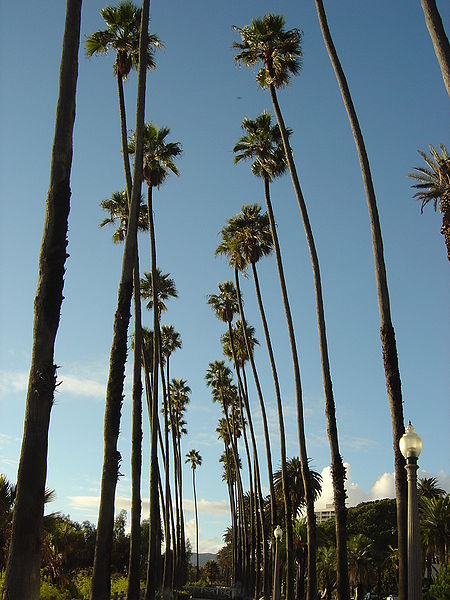for Mishari Al-Adwani
They say this part of California
Is paradise on earth for the roof rat,
Who loves the palms & vines of the middle classes,
The ubiquitous fruits, the delectable nuts & ivy.
Just another genus struggling to become indigenous,
When it arrives they switch the menus. But it won't leave.
Palm trees (Washingtonia robusta), Santa Monica, Ca.: photo by Infratec, 2006




4 comments:
Thank you, Tom. I'm honoured.
Thanks Tom, another bit here of parallel universes ("animal or plant") - - -
2.21
pink line of cloud above shadowed green
ridge, song sparrow calling from branch
in foreground, sound of wave in channel
surface in pattern of lines,
something which first
relation itself in the word,
e.g., animal or plant
grey-white of sky reflected in channel,
wingspan of gull flapping toward point
I read up on the roof rat (what a fine description, what a great name, although rattus rattus is obviously very appealing and catchy). Based on the photo and my current vantage point from the deep snow of brown rat country, I can see that Santa Monica rooftops, vistas and vegetation would be irresistable. The last two lines of the poem tell the current story of my life, so thank you very much; I'll quote them when I need to and spare my listeners/inquisitors from something more longwinded and less precise.
Steve,
Well What we have here seems to be a case of animal AND plant, the former happily (happily for itself, anyway) at home in the latter.
Curtis,
I think I know what you mean.
This poem comes from a book called Under the Fortune Palms, in which the several emblems for the figure of the poet included the roof rat and the wild dog. Both these creatures had a modus operandi for survival that featured a persistent group presence, though, and when it came to living up to the characteristics of one's chosen emblems, that was the rub. As pretty much an isolato in those parts (Santa Barbara it was, actually), and thus permanently on the defensive as well as on the outside looking in, there was always the problem of not being able to summon up a horde or a pack to support one. The wild dogs of Downey and Hawthorne and other such charming locales of the LA supra-urban sprawlzone traveled in groups of a dozen or more at a time. And when you saw a roof rat skulking out of a palm tree, you could be pretty sure there were more of them hiding up there in the complex structure under the overarching fronds. How can a mere monad match that kind of survivalist social organization?
(One hastens to add that all this is/was a matter of mere literary caricature of course, enabled by poetic license & c.)
Post a Comment